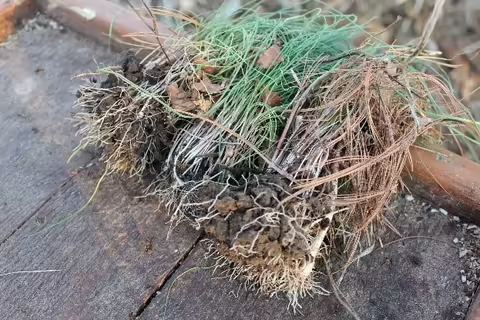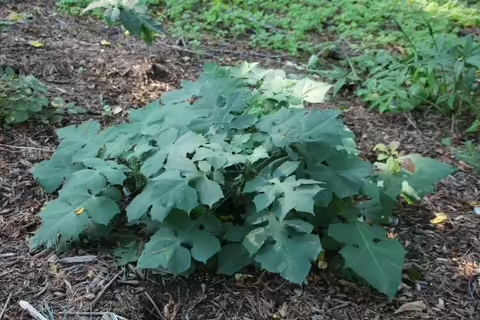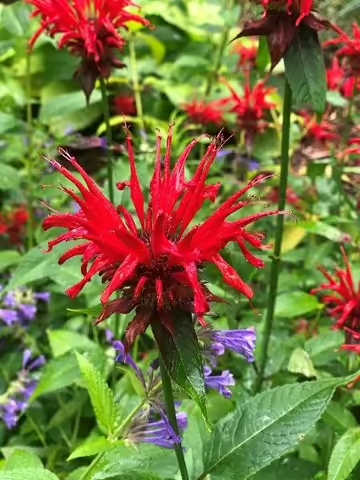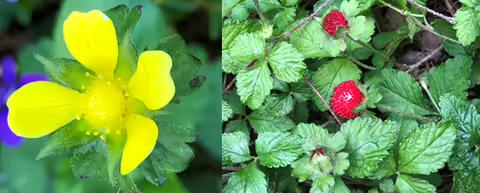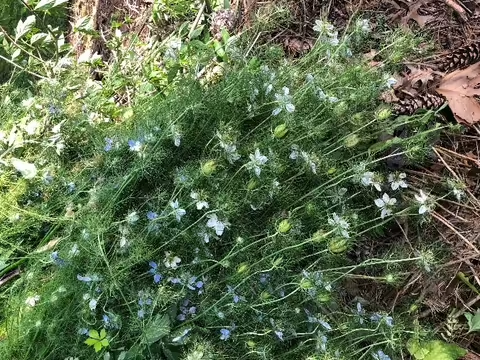Not all the garden plants in my jungle are polite. Skullcap (Scutellaria spp.), Solomon’s seal (Polygonatum spp.), green dragon (Pinellia tripartite), bell flowers (Campanula spp.), field scabiosa (Knautia arvensis), salvia (Salvia spp.), mountain mints (Pycnanthemum spp.), Ohio horse mint (Blephilia ciliata) , common violet (Viola spp.), golden alexanders (Zizia aurea), daylilies (Hemerocallis spp.), dogwood (Cornus spp.), beardtongue (Penstemon digitalis) and hybrid anemones (Anemone x hybrida) are all plants that want more than their fair share of space. I have to contemplate annually whether I love them “enough” to keep. Usually the answer is yes. But as I get older, my buy-in gets weaker and weaker for thuggish species or cultivars that require a lot of work keeping plant numbers in check.
I got to thinking about what tips the scale for me to throw in the towel and enact total eradication. Two things come to mind; when undesirable plants are difficult to remove, and/or spread well beyond the original planting in huge numbers. Garlic chives (Allium tuberosum) fulfilled both of my criteria 17 years ago. I was sure when I planted them, I would be on top of deadheading all the flowers before they went to seed. Clearly I missed some because I am still digging out stragglers today. I am also still eradicating whiteflower leafcup (Polymnia canadensis), a native I planted for its suitability to a forest setting with dappled light and uniform moisture. Even though I was thrilled with the performance of the original plant, the resulting carpet of seedlings spread far and wide making eradication a necessary decision three years ago. Clearly the “can reseed in optimal conditions” tag fit my jungle site perfectly and I should have paid heed to the warning.
Green dragon and black chokeberries are both currently pressing their luck with me. Green dragon reproduces by bulb offsets, bulbils, and self-seeding, so has the capability of invading everywhere, and in number. They are easy to pull when just emerging, but become increasing more difficult to hand pull as they increase in number and size. Some dogwoods like the gray dogwood (Cornus racemosa) are a different pain all together, they can form new plants through suckers along the entire root system, requiring multiple repeat pruning removals throughout the active growing season. You have to know how bad it is, when I am contemplating removing a well-established large shrub that is not only beautiful in bloom, but produces berries for wildlife.
I am usually very aggressive in thinning thug plants I’ve decided to keep because I know they will regrow much of what I took away, usually by season’s end. Take ‘Jacob Cline’ beebalm (Monarda didyma) as an example of one stunning thuggish plant. Like most members of the mint family, it will continue to spread until it hits a brick wall, literally. Every spring when it is about a foot tall, I thin out spindly growth and reduce the overall size of the clump to maybe a foot across. At this time, I insert a circular wire plant support over the clump to prevent lodging of the stems as they elongate. So far, it is not in danger of elimination.
Of course, I have also been editing out volunteer plants I never intended to grow in my jungle, including the mock strawberry (Potentilla indica). Be advised, be on the lookout for yellow-flowered strawberry-like plants spreading via runners across garden beds and through the lawn. Don’t be fooled though, it’s not an alpine strawberry. Take my word for it, even though the alpine strawberry-like fruit may technically be edible, they leave behind no desire to ever sample another. The mock strawberry can form a dense mat, choking out both grass and smaller garden plants. I would put it in the same category as ground ivy, a.k.a. creeping Charlie (Glechoma hederacea). Nasty!
Other plants just need an occasional adjustment in density within a planting, including both hardy annuals (reseeds) and perennials. Love-in-a-mist (Nigella spp.) can reseed to the point of dominating entire beds and usually needs to be significantly thinned. I find the need to thin twice; once early when they are around a foot tall so surrounding plants don’t become crowded and obscured, and again just before plants go to seed to limit the number of plants the following year. Plants like beardtongue can give nice height in a mixed plantings but tends to overwhelm the color and texture of the planting over time if not thinned occasionally. If all you see is one dominant species in a mixed planting, it’s time to make a few judicious removals.
